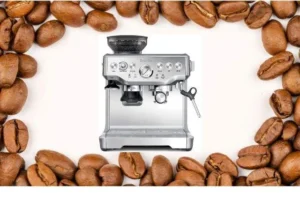Unveiling the Art and Science of Latte Making: A Comprehensive Guide
Introduction
The alluring aroma of freshly ground espresso beans. The delicately textured steamed milk. The canvas of foam is ready for artistry. These elements come together in one beloved drink: the latte.
More than just a caffeine boost, a latte encapsulates craft and comfort. It balances the art and science of coffee making. This satisfies both coffee enthusiasts and casual sippers.
This ubiquitous yet complex drink has evolved from Italian coffee culture. It has become a menu staple around the world. Its popularity speaks to finding the perfect espresso-to-steamed milk ratio in each sip. Many new to lattes wonder about the secrets baristas use to make the ideal latte.
Whether seeking latte expertise or enhancing your coffee ritual, this guide unveils latte mastery art and science. Let’s begin our latte journey.
Key Takeaways
- Latte’s Origins and Global Appeal: The latte originated in Italy in the 1950s as a blend of espresso and milk, becoming a symbol of comfort and relaxation worldwide.
- Essentials for Latte Making: To craft a perfect latte, you need quality coffee beans, the right milk, and essential equipment like an espresso machine, grinder, and milk steamer.
- Crafting a Perfect Latte: Making a great latte involves pulling an aromatic espresso shot, steaming milk to a silky texture, and creating visually appealing latte art.
- Latte Art and Flavor Variations: Latte art adds creativity to the drink, and there are endless flavor possibilities, from vanilla to unique seasonal choices.

The History of the Latte
The latte has humble beginnings. Its origins trace back to Italy in the 1950s. Here, espresso reigns supreme. The drinking of this strong, concentrated coffee is a daily ritual.
In Italian coffee culture, milk softens espresso’s intensity. The first lattes simply added a dollop of milk to a shot of espresso. Lattes then evolved with more steamed milk and less froth. The milk tames espresso’s bitterness and creates a creamy, comforting drink.
The name “latte” comes from the Italian word for milk, “latte.” In Italy, ordering a “latte” means you’ll receive a glass of milk. Italians specify “un caffe latte” for the espresso and milk drink.
The latte spread beyond Italy in the 1980s with the rise of specialty coffee shops. The global latte phenomenon began in Seattle with Starbucks. Customizations like flavored syrups and frothy art made the latte increasingly trendy worldwide.
The latte holds cultural symbolism too. It represents tranquility and comfort amid busy modern life. Savoring a latte is a ritual signifying taking time to enjoy the moment. Sip by sip, the latte provides both stimulation and satisfaction.
From humble origins in Italy to global sensation, the latte remains an icon. It continues evolving across cultures while retaining its essence. No matter how you take your latte, it represents a perfect balance of craft and care.
The Essentials: Ingredients and Equipment
Crafting the ideal latte requires mastery of two core components: espresso and steamed milk. Achieving the perfect balance begins with selecting the right ingredients and equipment.
Coffee Beans Are Key
The foundation of any great latte is high-quality espresso. This starts with buying fresh coffee beans and proper storage. Seek out beans with flavor notes like chocolate, nuts, or berries. Light or medium roasts allow the bean’s natural flavors to shine. Store beans in an airtight container away from light, air, moisture, and heat.
Choosing the Right Milk
Whole milk is the gold standard for latte recipes, but lower-fat varieties work too. Non-dairy milk like soy, almond, or oat milk can also be used. Each milk’s fat and protein content impacts texture and flavor. Experiment to find your favorite.
Essential Equipment
- Espresso machine: Crafts the espresso. Manual lever machines provide control, automatic ones offer ease of use.
- Burr grinder: Grinds beans into a uniform, consistent texture.
- Milk steamer: Steams and froths the milk using steam wands.
- Thermometer: Ensures the milk is heated to the ideal temperature.
- Tampers, shot glasses: Useful tools that optimize the espresso-making process.
The right beans, milk, and equipment form the foundation for latte excellence. With these essentials covered, we can dive into latte preparation techniques.

Crafting the Perfect Latte
Creating the ideal latte is an art form that takes practice to perfect. However, following these key steps can help you craft cafe-quality lattes at home:
- Pull the espresso shot: Aim for 1-2 ounces of aromatic, hazelnut-hued espresso with a creamy froth top.
- Steam the milk: Create a smooth, silky microfoam that doubles the milk’s volume. Heat to 150-155°F.
- Combine and finish with art: Pour steamed milk into espresso. Scoop microfoam on top. Etch designs into the foam.
- Enhance flavor: Use high-quality beans, grind fresh, tamp firmly, and clean equipment between cups.
With quality ingredients, dialed-in techniques, and practice, you’ll be able to craft the perfect latte. The contrast of espresso and foamed milk creates stunning visual creations to savor.
The Art of Steaming Milk
Properly steaming milk is crucial for latte perfection.
- Select the right milk: Whole milk works best, lower fat milk froths better but lacks richness. Non-dairy milk froth differently.
- Master temperature and texture: Heat milk to 150-155°F to scald and coax out sweetness. Create smooth, silky microfoam.
- Use proper frothing technique: Keep the steam wand tip at the surface, and tilt/swirl the pitcher to incorporate air. Work quickly.
- Troubleshoot issues: Adjust steam wand placement and angle if milk isn’t steaming properly. Rinse the steam wand immediately after use.
Mastering milk steaming and frothing is challenging but pays off in creating rich, sweet lattes with balanced flavors. Following these tips will help perfect the latte art.

Mastering Latte Art
Latte art transforms a simple drink into a canvas for creativity.
History and Significance
Latte art emerged in the 1980s and became a signature of third-wave coffee shops. It makes the drink visually appealing and shows the barista’s pouring skills.
Classic Designs
Basic shapes like hearts, rosettes, and tulips are poured by gently tilting the cup and “drawing” in the foam. Start with these to build foundational skills.
Advanced Techniques
Go beyond shapes to etching, 3D, and layered designs. Etch with a toothpick. Layer contrasting milks. Create dimensional foam art.
Instagrammable Art
Use symmetry, contrast, negative space, and rich colors. Incorporate logos or themes. Take photos from multiple angles for social media.
With practice, you can progress from basic patterns to advanced designs and create latte art worthy of Instagram.
Flavorful Variations
While traditional lattes showcase the harmony of espresso and steamed milk, creative baristas have dreamed up endless flavorful variations. The possibilities are limited only by your imagination.
Popular flavored latte recipes include:
- Vanilla: This classic enhances the latte’s sweetness with vanilla syrup or extract. Pairs nicely with vanilla beans in the espresso.
- Caramel: Butterscotch flavor adds warmth. Drizzle the inside of the cup with caramel sauce before pouring.
- Pumpkin spice: Evokes cozy fall days with pumpkin pie spices like cinnamon, nutmeg, and cloves.
- Peppermint mocha: A festive seasonal treat combining peppermint and chocolate flavors.
Flavored syrups, sauces, spices, and extracts open up an endless array of options. Try rotating seasonal flavors like eggnog or gingerbread for limited-time treats. The possibilities are endless when crafting flavorful latte variations.

Troubleshooting Common Latte Issues
Even experienced baristas occasionally run into problems making lattes. Here are some common issues and ways to fix them:
| Issue | Potential Causes | Solutions |
| Bitter, over-extracted espresso | Coffee ground too finely, overtamped, water too hot | Grind coarser, lighten tamp, lower water temp |
| Milk not frothing properly | Steam wand placement, milk temp, old milk | Adjust wand depth, use colder milk, swap fresh milk |
| Latte art collapsing | Milk is too hot, espresso shots off ratio | Brew espresso correctly, and steam milk just below 155°F |
| Watery latte | Not enough espresso, milk oversteamed | Pull more robust shots, steam milk less |
| Thick, gloppy latte | Too much espresso, milk understeamed | Add more steamed milk, increase milk volume |
| Equipment issues | Mineral buildup, worn parts, calibration | Descale regularly, replace parts, get machine serviced |
Diagnosing and fixing these common issues takes practice. With time, you’ll learn how to adjust to avoid latte mistakes. Record recipes that work to replicate them perfectly.
Healthy and Dairy-Free Options
Making lattes part of a healthy diet is easy with simple substitutions:
Dairy-Free Milks
Substitute dairy milk with soy, almond, oat, coconut, or other plant-based milk. Each lends its own flavor and texture.
Low-Calorie Options
Skip the high-fat whole milk and opt for skim or 1%. Limit added sugar by using sugar-free flavorings.
Nutritional Benefits
Lattes offer antioxidants from coffee and protein, vitamin D, and calcium from dairy or plant-based milk. Control calories, sugar, and fat based on your needs.
With so many milk varieties and ways to customize, you can craft a latte that perfectly balances nutrition and indulgence. Explore different options to find your ideal healthy latte.

The Latte Experience Around the World
The latte has been customized across cultures, spawning regional recipes.
- Hong Kong milky tea: Black tea with milk, often condensed milk. A latte twist.
- Indian ginger latte: Chai concentrate with espresso and frothy milk. Warming and aromatic.
- Mexican cafe de olla: Espresso, cinnamon, brown sugar, and milk. Sweet and spiced.
- Australian flat white: Espresso topped with thin velvety steamed milk. Smooth and strong.
- Cuban cortadito: Sweetened espresso with warm milk. Intense yet mellowed by sugar.
- Portuguese galão: Espresso with foamed milk. Similar to a latte but less milk.
These global interpretations use local ingredients to make the latte their own. Part of the joy of travel is discovering regional latte varieties!
Conclusion
The ubiquitous yet complex latte encapsulates both art and science. As we’ve explored, crafting the ideal latte requires selecting high-quality ingredients and mastering techniques like espresso pulling and milk steaming.
Latte art transforms the drink into a canvas for creativity and self-expression. Troubleshooting common issues takes practice but is key to consistency.
While rooted in Italian espresso culture, the latte has evolved globally with unique regional interpretations. For many, savoring a perfectly crafted latte is a daily ritual that represents taking time to enjoy life’s small pleasures.
The journey of latte mastery is a lifelong one, filled with continual refinement. May this guide inspire you to embrace your creativity and passion as you explore the possibilities for crafting your perfect latte.
FAQs
A. A latte has more steamed milk, resulting in a creamier drink. A cappuccino uses less milk and features more foam.
A. You can mimic espresso using an Aeropress or Moka pot but will lack the espresso crema. Frothing without a steam wand is challenging.
A. Start with a heart shape, then build up to tulips. Pour slowly and keep the pitcher close to the cup. Use whole milk for the best foam texture.
A. Yes, use decaffeinated espresso beans and your favorite milk to create a caffeine-free latte.
A. Soy and oat milk steam and froth the most similar to dairy milk. Nut milks also produce decent foam.








